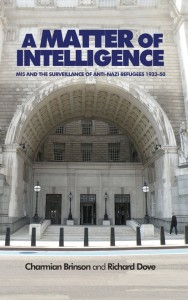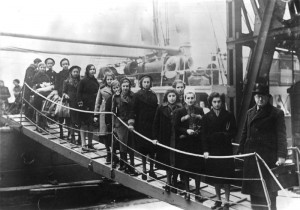Review: how we spied on the anti-Nazis who fled to Britain
Merilyn Moos Reviews “A Matter of Intelligence. M15 and the Surveillance of Anti-Nazi Refugees 1933-50” by Charmian Brinson and Richard Dove.
We too often think of the consequences of Nazism as something far away from us. But many of the refugees who came to the UK between 1933 and 1939 ended up living in and around Camden, especially in Hampstead, as well as in other parts of North London.
Two books have recently come out about the refugees. The first is Brinson and Dove’s: ‘A matter of intelligence. MI5 and the surveillance of anti-nazi refugees 1933-50’ (Manchester University Press). Many of the people who are featured here settled in and around North London, making it their second home.
 The people who fled the Nazis’ virulent antisemitism are generally thought of as the refugees who escaped Nazism. But the anti-Nazi refugees who arrived in the UK in the 1930s, earlier than the exodus after the 1938 pogrom and the invasion of Czechoslovakia, are too often hidden from history. This is a book which focuses on them and provides us with an analysis of how intently MI5 spied on and harassed anti-Nazi refugees, and how ideologically driven and incompetent MI5 were.
The people who fled the Nazis’ virulent antisemitism are generally thought of as the refugees who escaped Nazism. But the anti-Nazi refugees who arrived in the UK in the 1930s, earlier than the exodus after the 1938 pogrom and the invasion of Czechoslovakia, are too often hidden from history. This is a book which focuses on them and provides us with an analysis of how intently MI5 spied on and harassed anti-Nazi refugees, and how ideologically driven and incompetent MI5 were.
Nobody knows exactly how many German Communist exiles there were in Britain. Up till the November 1938 pogrom (Krystallnacht), we are probably talking of only about twenty, though there were a few dozen other people who were on the fringes of the German Communist Party, and others, such as the musician Hans Eisler, who worked with Brecht, who passed through the UK. After the 1938 pogrom and, a few months later, the invasion of Czechoslovakia, the numbers of anti-Nazi refugees increased considerably, despite the Government’s criteria of entry not facilitating left-wingers gaining admission. The figure of how many refugees from Nazism arrived in the UK altogether is disputed and varies from about 50-80,000.
Many famous anti-Nazi refugees graced N. London. The Kuczinski family, who lived in Hampstead, included father Robert, a leading German economist, son, Jurgen, who was a leading member of the German Communist Party (KPD) who was to become a spy for the USSR and later a leading East German economist and his two famous left-wing sisters. Ernst Hermann Meyer, already a well-known musicologist, and a member of the German Communist Party, who was to later become the musical darling of East Germany, lived in Parliament Hill.
Then there was Dora Fabian, a political activist and member of the German SAP, and Mathilde Wurm, a Social Democratic member of the Reichstag, who lived in Bloomsbury – where they were murdered (case unsolved). My parents too – my father, a leading figure in left–wing theatre in Berlin and an activist member of the Communist Party, lived in various places around Hampstead, my mother at one point in the Lawn Road flats (see below).
From 1933, much of MI5’s resources were devoted to their surveillance and investigation of German – and subsequently Austrian – Communist refugees. Originally established in 1909 to combat German espionage, MI5 quickly took up the good fight against Communism. Indeed, although would-be refugees from the German and Austrian Social Democratic Parties also faced sometimes insuperable obstacles in getting permission to enter the UK, once in, MI5 seems to have disregarded them almost completely.
MI5 spied on the anti-Nazi refugees from as soon as they started to arrive in 1933. Opening their mail was a favoured pursuit as well as direct observation. They also infiltrated groups and friendship networks. The political exile groups’ policies of open recruitment made infiltration easy. The Communist exiles lived in dread. They were not allowed to participate in political activity as a condition of being granted temporary rights of residence. Indeed, any refugees who maintained underground political activity here had real cause for concern, especially as there were informants within the exile community.
The final tightening of the screw for many of these anti-Nazis was internment in 1940 when anti-Nazis and a few Nazis were packed together in internment camps, some in very poor conditions, something MI5 – and many historians – wish to avert their gaze from. Amidst talk of a ‘fifth column’ and the enemy within, MI5 saw its task, sometimes against Home Office advice, to intern people who had rights to temporary abode in a foreign – ‘democratic’ – country because they had opposed Nazism and had to escape or die.
As Brinson and Dove reveal, there were a number of leading figures in the UK who stood by the refugees, for example Fenner Brockway M.P, the writer J.B. Priestley, D.N.Pritt, Ellen Wilkinson M.P. and Eleanor Rathbone M.P. MI5 kept files on all of them, some, such as Priestley, went up to 1960!
But there is hope yet. What emerges from this book is how much MI5 bungled: they concentrated on people who were harmless and let other ‘real spies’ slip by. MI5 failed to identify or prioritise the very few cases which could be defined as a ‘security risk’. They failed to spot Klaus Fuchs, the ‘atomic spy’ for the USSR until late in the 1940s. In the case of his fellow atomic spy, Englebert Broda, they failed to take any action at all. In the case of Edith Tudor-Hart, they may have kept policemen on watch outside her house and intercepted her mail in the 1930’s, but they did not even realise she was a member of the Communist Party, never mind a crucial – and probably double -agent. Nor did they pick up a leading anti-Nazi Communist who was spying for the USSR: Jurgen Kuzcinski. In the meantime, however, many political refugees were left feeling overwhelmed with a deep fear of being spied on and deported.
Why were MI5 obsessed? Two if not three of their bug-bears coincided in the person of the German anti-Nazi refugees: firstly, they were German, secondly, they were Communists and God forbid, many of them were Jews as well. Kell, who had risen to be MI5 boss, was far more sympathetic to the fascists than the Communists. The British Union of Fascists he saw at one time as a patriotic bunch, representing the interests of all, unlike those Communist class warriors.
 A second book has recently come out about the refugees, whose characters overlap significantly with the Brinson and Dove study. ‘The Lawn Road Flats’ by David Burke is about the people who lived in a block of flats during the 1930s, bang in the middle of Hampstead.
A second book has recently come out about the refugees, whose characters overlap significantly with the Brinson and Dove study. ‘The Lawn Road Flats’ by David Burke is about the people who lived in a block of flats during the 1930s, bang in the middle of Hampstead.
The Lawn Road flats, which can still be visited, were amongst the first modernist buildings constructed in Britain, using reinforced concrete which demanded new building techniques. Burke builds up a picture of a network of refugees with Soviet contacts who move into Lawn Road (including, by suggestion, my mother).
Surprisingly, Agatha Christie also lived there for parts of the time. According to Burke, Arnold Deutsch, the controller of the group of Cambridge spies; the photographer Edith Tudor-Hart (see above) and Melita Norwood, another Soviet spy and the in/famous Kuczinski clan all lived here. In fact, the flats became the centre for other leading German refugees, such as the Bauhaus exiles Walter Gropius, László Moholy-Nagy and Marcel Breuer, and the Marxist historian V. Gordon Childe;
But Burke depends far too heavily for his material on the Communists and fellow-travellers on British – indeed MI5 – sources. Given MI5’s lively obsession with finding reds under every bed, and that every refugee was a potential Communist and spy (especially if Jewish) – and most of the residents in the Lawn Road flats were refugees, MI5 is not a reliable source. He also has an over-reliance on the testimony of the Russian double agent, Krevitsky, who provided MI5 with a list of people he suspected of being spies for the Russians (again-falsely- including my mother) and got himself murdered in a New York hotel for his pains. But the main underlying problem with the book is that it focuses on the different lives of the ‘spies’ and fellow travellers but without offering a political analysis of why they went along with, even spied for, the USSR.
It is time for us, in North London, to remember some of these brave people who stood up to the Nazis and risked their lives doing so, and who were able (as tens of thousands were not) to gain entry into the UK, many of whom settled around here. These two books cast light on their lives.



Join the discussion